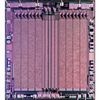1965: Semiconductor Read-Only-Memory arrays
Fixed semiconductor ROMs offer high density and low cost per bit




A read-only-memory (ROM) stores information intended to be fixed for the life of a system in character generation, look-up tables, microprogram code and other applications. The earliest semiconductor ROMs comprised arrays of discrete diode devices connecting rows and columns of signal wires on printed circuit boards. A one or zero is represented by the presence or absence of a diode in the matrix. In an integrated circuit (IC) ROM, the last step of the fabrication process makes connection only to the specific diodes required. As a diode forms the smallest possible memory cell, ROM devices offer the highest density and lowest cost/bit form of semiconductor memory.
Sylvania Electronic Components, Woburn, MA produced a 256-bit bipolar TTL ROM for Honeywell in 1965. Codes were programmed one bit at a time by physically scratching metal link connections to selected diodes. Also in 1965, General Microelectronics developed 1024-bit custom-mask programmed ROMs using MOS technology. By the early 1970s Fairchild, Intel, Motorola, Signetics, and TI offered 1024-bit high-speed bipolar ROMs, while AMD, AMI, Electronic Arrays, General Instrument, National, Rockwell and others produced 4096-bit (4K) MOS devices.
Early high-volume ROM applications in desktop calculators were surpassed by video game cartridges that used hundreds of millions of 16K and larger devices from U. S. and Japanese vendors. Production of Nintendo's first Super Mario Brothers NES game alone exceeded 40M units. ROM chips held program information for early microprocessor designs. Microcontrollers integrated the function onto the CPU chip for applications ranging from automobile engine control to garage door openers. In the early 1980s, user-programmable ROMs (PROMs) employing fuses and EPROM non-volatile memory (NVM) cells replaced mask-programmable devices in prototyping and small volume applications.
1965_ROM_v2
Rev: 5.18.15
Contemporary Documents
- Boysel, Lee. "Memory on a Chip: A Step toward Large Scale Integration" Electronics (Feb. 6, 1967) p. 92
- Boysel, Lee. "Cutting System Cost with MOS" Electronics (January 20, 1969) pp. 105-107
- Cook et al. “Read-Only Memory Fabrication by Laser Formed Connections” *IBM Technical Disclosure BulletinP, Vol. 15, No. 8 (Jan. 1973) pp. 2371-2372.
- Cheney, Glen, T., John Richard Edwards “Methods for making MOS read-only memories” U.S. Patent 3,914,855 (Filed: May 9, 1974 Issued: Oct 28, 1975)
- Ashby, Robert M., Chapelle Theodore J La, Gordon H Smith “Integrated circuit diode matrix” U.S. Patent 3,377,513 (Filed: May 2, 1966 Issued: Apr 9, 1968)
More Information
- Finn, Calvin L. "All Semiconductor Memory System Includes Read-Only and Read/Write Chips" HP Journal (December, 1972) pp. 22-24
- Krummel, L. and Schultz, G. “Advances in Microcomputer Development Systems” IEEE Computer Vol:10, Issue: 2 (February 1977) pp. 13 - 19
Oral Histories
- “Interview with Jack Balletto (Synertek)” Silicon Genesis (2012) [Retrieved on 8.4.15 from: http://silicongenesis.stanford.edu/transcripts/balleto.htm]
1965_ROM_v2
Rev: 5.18.15


